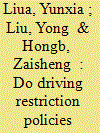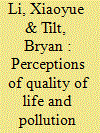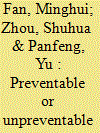| Srl | Item |
| 1 |
ID:
150803


|
|
|
|
|
| Summary/Abstract |
Driving restriction policies have been implemented in some large Chinese cities to cope with severe urban smog pollution. We explored the roles of policy acceptance and other factors in commuters' transport mode decisions, based on the Theory of Planned Behavior. A questionnaire survey was conducted in Tianjin, China. A structural equation model was developed to test eight hypotheses, two of which were rejected. The results indicate that a driving restriction policy alone cannot effectively motivate commuters to use public transport if the policymakers fail to improve public transport, enhance commuters' awareness of consequences, increase commuters' perceived behavior control, and encourage car owners to change driving behavior. Comparisons between car owners and non-owners indicated that car owners view driving restriction policy and public transport more negatively. These negative views could be a barrier for the promotion of public transport among car owners. In addition, attitude toward public transport was found to have positive correlation with commuting time.
|
|
|
|
|
|
|
|
|
|
|
|
|
|
|
|
| 2 |
ID:
159837


|
|
|
|
|
| Summary/Abstract |
After decades of rapid economic development, China is facing severe environmental problems. In particular, smog in urban areas has recently attracted a great deal of scientific and media attention both domestically and internationally. Our focus in this article is on public perceptions of smog in the northern city of Tangshan, which is routinely ranked as one of the urban areas with the worst air quality in the nation. In this article, we present the results of qualitative interviews and quantitative surveys with 341 urban residents. We examine how these residents perceive and weigh the importance of various aspects related to quality of life, including their experience with air pollution. Study participants considered environmental quality an issue of lower priority than many others; however, they surprisingly ranked it over economic concerns such as jobs and income. Their responses suggest that, for many urban residents, environmental problems like smog are fundamentally linked to basic quality of life concerns such as physical health and family well-being. We interpret our findings in the context of literature on the rise of China's middle class, the rise of environmental consciousness, and the role of gender in mediating perceptions of pollution and family health. We also consider the implications of these findings for the control and remediation of air pollution in China today.
|
|
|
|
|
|
|
|
|
|
|
|
|
|
|
|
| 3 |
ID:
171149


|
|
|
|
|
| Summary/Abstract |
China’s polluted air has seriously affected the health of the Chinese population. This paper uses attribution theory to investigate how Chinese newspapers and non-Chinese newspapers presented smog in China and attributed causes and responsibilities. Built on previous studies, this study adopted covariation model within attribution theory and painted an interesting picture of smog coverage by Chinese and non-Chinese newspapers because of the apparent differences in perspectives. The criteria further provided folder for elaboration on explaining why the different coverages attributed causes as they did. Implications are discussed.
|
|
|
|
|
|
|
|
|
|
|
|
|
|
|
|